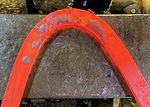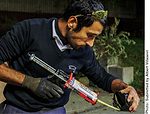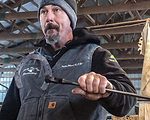Advertise Follow Us
American Farriers Journal

View Archived Issues
April 2021
Volume: 47
Edition: 3
American Farriers Journal is the “hands-on” magazine for professional farriers, equine veterinarians and horse care product and service buyers.
-
Table Of Contents
Table Of Contents
Improve Your Forge Work with the 4 Stages of Learning
Understanding the “Conscious Competence Ladder’ can help you navigate the highs and lows of learning a skillRead MoreAnatomical Knowledge is the Foundation to Understanding Biomechanics
Optimal performance requires balanced interaction of all elements of the distal limbRead MoreWhat are Your Options for Achieving the Benefits of a Sidebone Shoe?
Alternatives are affordable, but forging experience is a mustRead MoreHow to be Successful When Using Hoof Boots
Knowledge of alternative footgear options will expand a hoof-care professional’s toolboxRead MoreSouth African Farrier Sees Great Potential in 3D Printing
Improving technology leads to better quality materials and faster productionRead MoreHow to Make a “Farley” Hospital Plate
This nine-step instructional will help farriers fabricate a “Farley plate” to help horses in various therapeutic needs.Read MoreTips for Drilling and Tapping Horseshoes
Save time and money by employing better practices in a deceptively difficult approachRead MoreSteps to Make a High Scoring Square Toe Horseshoe
Master shoe modifications before taking the certified farrier examRead MoreBadass Rigs & TrailersSmall Trailer Adds to Career Longevity
Using smaller trailers has saved wear and tear to lengthen Indiana farrier’s shoeing careerRead MoreNews & NotesThree Up-and-coming Farriers are Honored for Early Career Success
Rising Shoeing Stars share the lessons they have learned since graduationRead MoreA Shoe Fit for a Farrier
Conformation is an important consideration when choosing equine and human footwearRead MoreResearch Journal: April 2021
The information, ideas and opinions expressed are those of the author and do not necessarily represent those of the United States Department of Agriculture.Read More -
Featured Articles
Featured Articles
Improve Your Forge Work with the 4 Stages of Learning
Understanding the “Conscious Competence Ladder’ can help you navigate the highs and lows of learning a skillRead MoreSouth African Farrier Sees Great Potential in 3D Printing
Improving technology leads to better quality materials and faster productionRead MoreHow to Make a “Farley” Hospital Plate
This nine-step instructional will help farriers fabricate a “Farley plate” to help horses in various therapeutic needs.Read More - Digital Edition
-
Online Extras
Online Extras






















